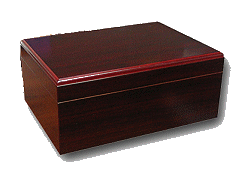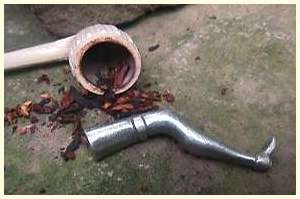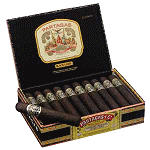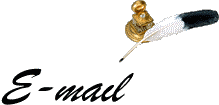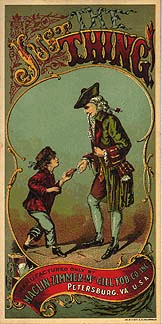

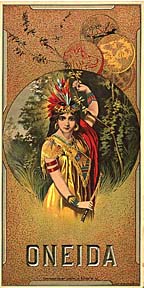
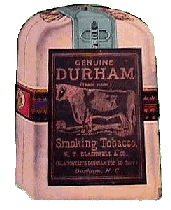
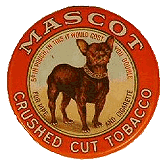
Tobacco 2
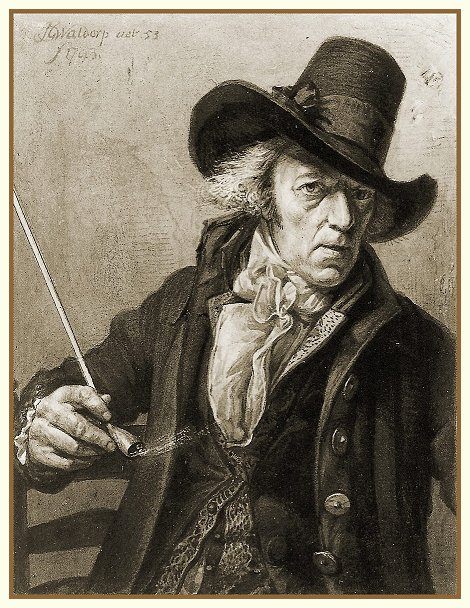
The social and economic history of the United States has been influenced tremendously by tobacco. The American Indians were the first to smoke tobacco and the Portuguese and Spanish introduced the custom to Europe. Probably because not only the Dutch who settled New Amsterdam but also those who stayed at home so greatly enjoyed their smoking, Holland more than any other nation devised accessories to help make this habit a pleasure. And, of course, tobacco became the financial mainstay of the colony of Virginia.
Pipes are the oldest method of enjoying tobacco. The Indians held the tobacco that they smoked in shells or simple clay pipes or horns. The white settlers used longstemmed clay pipes, many of them made in Liverpool and Scotland. Steel pipes, introduced in the eighteenth century, became popular with sailors and stagecoach passengers because they did not break as easily as clay ones. Meerschaum, porcelain, and ivory were used for the bowls of pipes, which often were carved or painted.
Because tobacco was a costly luxury, pouches were made to carry and keep safe any small amount. Then came tobacco boxes. Narrow brass boxes, embossed, were exported everywhere from Holland during the seventeenth century. Lead and pewter ones came from England.
Other accessories included long tongs with which to pluck a coal from the fireplace to light a pipe. These appeared during the 1700's, as did tinder boxes with flints and steel, often designed in the shape of a pistol. Then there were pipe tampers. That century also, brought the introduction of smoking stands and hanging pipe racks. The latter usually had a drawer at the base for tobacco.
Tobacco jars also have been made since the 1700's. Usually these were not only a container for pipe tobacco or cigars but a humidor as well. Although tin, pewter, and some other materials were used for tobacco jars, the greatest variety was made in pottery and porcelain. Delft, majolica, bisque, and porcelain became common. Most of them had appropriate decorations. Some were shaped in the form of an animal or of an Indian or a white man smoking, and appropriately colored. On others, only the covers or knobs had shapes linked to smoking.
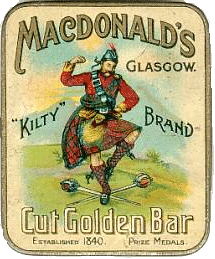
Pipe smoking was well established by the early 1600s throughout Europe. In 1614, as commercial pressures increased, Philip III decreed that all tobacco produced in the Spanish New World should be shipped to Seville in Spain. This had the dual aim of controlling the supply of tobacco and developing Seville as the home of cigar production. Throughout Spain cigars soon became the de rigeur means of consuming tobacco.
In England, the first consignments of Virginia tobacco for pipe smoking had arrived and some 7,000 shops in London sold tobacco by 1615. By 1618 the Thirty Years War contributed to the popularity of smoking, and in 1619, the first Africans were taken to Virginia. In the same year tobacco started to be used as currency in Virginia and remained in circulation for the next 200 years
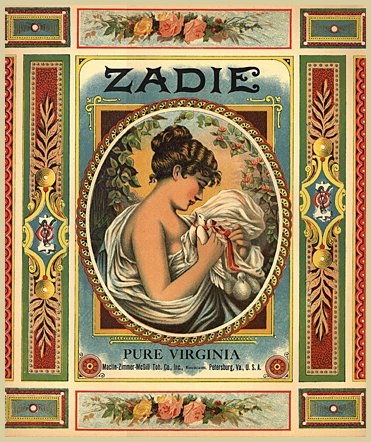
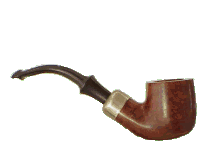
Types of Pipe Tobacco

Belt
Old Belt, important tobacco-growing regions in the U.S.A. and Canada.
Blumenau Tobacco
Brazilian tobacco named after the city of Blumenau in Brazil.
Burley
A blond to light-brown tobacco. Its aroma resembles cacao and improves with aging. Chiefly grown in the states of Kentucky and Tennessee in the U.S.A.
Cavendish Tobaccos
An extremely mild and aromatic pipe tobacco that is subjected to a special process involving heat and pressure. Dark, almost black in appearance.
Cube Cut
Pressed tobacco that is cut into small cubes.
Curly Cut
Pipe tobacco that is made by cutting leaves of light and dark raw tobacco into strips that are twisted into a thin rope. The rope is then cut into round slices.
Dark-fired
Dark Kentucky or Virginia tobacco that is cured and smoked over an open fire.
Dutch Mixtures
Pipe tobacco based upon mild Java varieties. Excellent burning characteristics, which explains their popularity among novice pipe smokers.
English Mixtures
Pipe tobaccos (Virginia) with a particularly full- bodied taste that is obtained by adding dark, aromatic tobaccos (e.g. Latakia or perique). English mixtures often contain no aromatic substances.
Fine-Cut Tobacco (Shag)
Tobacco for hand-rolling cigarettes that is cut into strips with a width of up to 1.2 millimeters.
Flake
A special type of compressed pipe tobacco that is cut into thin slices. It must be loosened by rubbing before it is put in the pipe.
Georgia
Flue-cured Virginia tobacco. A variety of Virginia tobacco from the state of Georgia that is very much in demand.
Kentucky Tobaccos
Tobacco from the states of Kentucky and Tennessee. Most commonly used to produce full-bodied tobaccos.
Latakia Tobacco
Aromatic black Oriental tobacco from Syria and Cyprus.
Maryland Tobaccos
Air-cured tobaccos from the state of Maryland.
Oriental Tobacco
Tobacco from the Balkans (Bulgaria, Greece, Rumania, Turkey, Albania, former Yugoslavia).
Perique
Black spiced tobacco from Louisiana.
Spun Cut
Clearly visible round or oval sections of cut ribs found in pipe and cigarette tobacco.
Virginia Tobacco
A collective term used for the large light and sweet leaves which originate from the states of Virginia, North and South Carolina, Georgia and Florida.
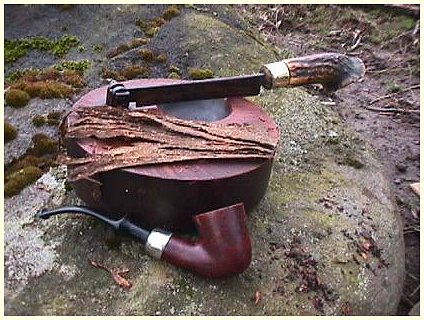
"Smoking is a necessity for a person engaged in study--it stimulates the intellect and revives the spirit should lassitude set in."
-Dr. Beintema, 1650

Plug Tobacco
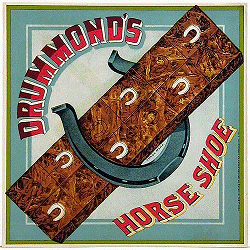
When a whole "block' of pressed tobacco is produced, and instead of cutting it into flakes or slices, the manufacturer would cut it into smaller "blocks" or "cubes", usually each weighing around 50g. (25g Plugs are also available in the UK, but they're rarer.) In the UK, this tobacco form is also sometimes referred to as "Bar Plug tobacco was what tobacco lovers would buy before manufacturers put tobacco in little cans or pouches. The tobacco came in a big brick, and customers would buy a couple of inches at a time. To make the measuring and cutting easier, tobacco companies supplied the stores with plug tobacco cutters. These cutters were made of iron, and consisted of a rounded area that housed the blade, a lever that moved the blade, and a base with rule marks for cutting precise amounts. Since the tobacco company supplied the device free of charge, they might put a little bit of advertising on the plug cutter as well. Plug cutters were common from the 1800s through the 1940s, and came in many different styles and shapes There were also simple cleaver style tobacco cutters that were used at home and in tobacco shops and country stores to cut tobacco. These were not as precise but did the job.
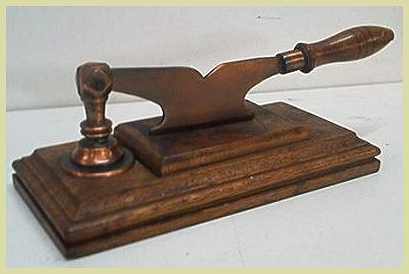
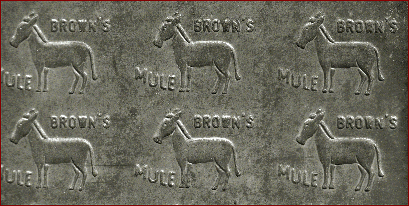
Plug Tobacco Molds were used in the manufacture of chewing/pipe tobacco. These molds were placed in the bottom of a wooden frame and then the tobacco was poured into the frame and spread evenly. A blank tin was placed on the top, placed under pressure and then sent to the curing room. After leaving the curing room the tobacco was sheared into plugs, wrapped and boxed for sale. The picture on this page represent only a section of the mold. The complete sheet measures 12" square. Each mold was used to produce 24 plugs. This item is part of the Boyle collection.
Tobacco Twist or Rope
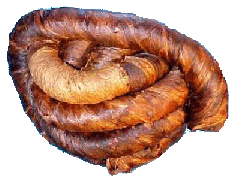
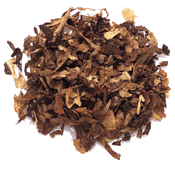
Rope or twist tobaccos are separated, hand woven, and spun into rope. The spool is placed into a steam press and cooked for 2-3 hours and then is rested in the press to cool for 6-8 hours. Throughout the known history of tobacco manufacturing, the art of leaf selection, stripping, and rolling has been one of the most crafted and difficult tasks in the industry. Originally, rope was one of the most common forms of finished tobacco products. The origin is lost to us but it is likely that rope tobacco originated with sailors who brought tobacco to Europe in the 16th century and who would have known well the art of rope making. Rope offers the consumer great versatility as it can be cut and smoked, chewed, or rasped to a coarse powder and snuffed. See the link below forSamuel Gawith & Co. They have been hand rolling rope since 1792 and the art is carried on by his sons, John and William, under the Gawith, Hoggarth & Co. name. Rope is created much like a cigar as the leaf must be selected for quality, color, and form; this allows the separation of outer wrapper and fill leafs. Women have often been used for this task because of their gentle dexterity and patience. Once the leaves are separated, the rolling process involves two operators; one to feed equal amounts of wrapper and filler while the other seaves the leaf. All of this takes place while a 19th century spooling machine is slowly pulling the rope away from the weaver. To create a two pound spool from leaf selection to finished product can take an average of six hours or longer if flavoring or pressing are to be involved.
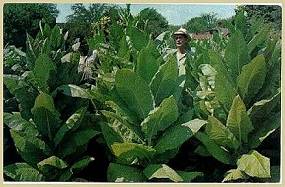
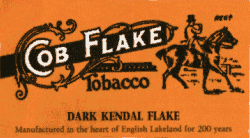
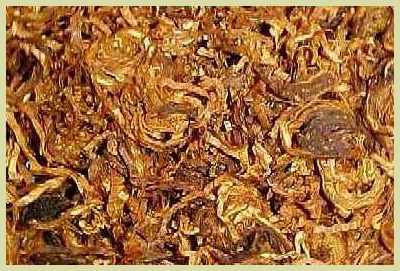
How to Smoke Flake Tobacco
This article is provided by McClelland Tobacco Company
English and Scottish-style Matured Virginia flake tobaccos are among the most interesting and rewarding for the smoker to taste; yet, they are avoided by many smokers who simply do not know how to approach them. This article is intended to help the pipe smoker learn how to fully appreciate the zesty character and subtle sweetness of these premium, aged products. (It should also help smokers of the flavored American sliced plug and European flake cavendish tobaccos.)
One reason flake tobaccos are left in slices after cake- maturing is that they retain their freshness better than in ribbon form. Flakes also enable the smoker to have some control over the burning rate and, to a small degree, the flavor.
It is important to prepare the tobacco before packing so that it has an even texture and to fill the bowl evenly, no matter what degree of brokenness is preferred. (The more fully-rubbed -- meaning gently separated -- a tobacco, the faster it will burn. Similarly, it is true that the thinner the cut, the faster it will burn).
The more moist tobaccos should be packed more loosely than normal so they won't pack down densely enough to prevent a good draft. The ideal is to have the tobacco draw firmly, with a little resistance, throughout the smoke. The smoker may be able barely to hear a little hissing through the pipe as it is smoked. Too firm and the tobacco won't burn at all or one small spot will burn hot and maybe wet as the smoker puffs hard to keep it going; too loose and the tobacco will burn inconsistently and unevenly, perhaps causing the bowl to overheat in spots and moisture to condense.
Five Steps to Success
1. Put in the palm of one hand the amount of tobacco that it is believed will fill the bowl. Then pinch at the slices or rub them between the palms until the tobacco separates to the degree preferred, keeping the texture even, avoiding clumps. The denser the tobacco is left, the slower it will burn. (This becomes especially valuable on windy days outdoors.)
2. Gently but firmly and evenly work the tobacco into the bowl of the pipe until it is filled slightly over the top and feels firm but still springy under enough finger pressure to flatten the surface of the tobacco even with the top of the pipe. (we assume the pipe is clean at the outset, free of obstruction to a good draft, well rested).
3. Now, while drawing through the stem, light the pipe evenly across the entire surface of the tobacco. After a few puffs to develop an ash, and while continuing to draw, tamp the tobacco down evenly all around the bowl with a tamper. The goal is to have the tobacco packed so that it will burn as evenly and firmly as a good cigar.
4. Relight the pipe after tamping to get the entire surface of the tobacco burning again. Even burning is very important. Otherwise, hot spots may develop.
5. With only occasional tamping as the tobacco burns down, since it tends to expand and loosen as it burns, the pipe should now smoke evenly to the bottom. The aim is to maintain a firm, even draft throughout the smoke. The process is not difficult to master and with practice will soon be effortless.
A Note on Flavor Expectations
For those who are used to the "aromatic" or sweetened tobaccos that dominate our market in the United States, it may take some time for the additives remaining in the pipe to dissipate. Many smokers prefer to maintain one set of pipes exclusively for the natural, matured tobaccos and another for the sweetened varieties.
It may be necessary to smoke Up to four ounces of a natural product before the mouth adjusts to the clean taste and subtler range of flavors typical of these Matured Virginia tobaccos. The smoker is rewarded for the effort as he becomes able to distinguish the delicate variations in taste and deepening richness these tobaccos develop as they are smoked.
McClelland Tobacco Co
(816) 474-6994
Po Box 7005
Kansas City, MO 64113
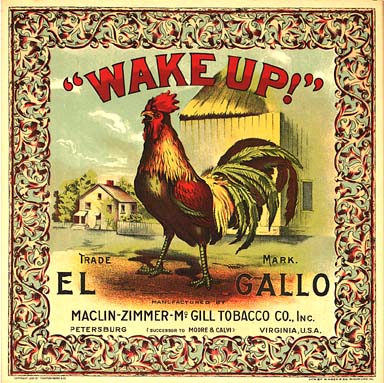
While tobacco smoke from pipes contains less of the carcinogenic substances found in cigarette smoke, it is nonetheless a health hazard, leading more often to cancers of the mouth and throat rather than the lungs. Addiction to nicotine is rarely involved unless the smoke is inhaled at a consumption rate comparable to heavy cigarette smoking. A 1964 study once showed that pipe smokers on average lived marginally longer than the general population, but that study failed to control for social factors and did not include an adequate representation of pipe smokers to be considered sound. Pipe smokers are inclined to attribute this to the calming, contemplative mindset promoted by the ritualistic character of pipe-use. However, it should be noted that there are almost no contemporary studies at all judging how dangerous pipe smoking may be: because more people smoke cigarettes and cigars, most studies focus on those. It would not be a good idea to assume that a lack of evidence implies a lack of danger: the smoker should monitor his health regarding smoking as he would any other lifestyle that can be abused, such as consumption of alcohol, cholesterol, or fat, among others.
Tobacco Links
I strongly dislike all cigarettes and cigars and always have, Smokless tobacco too. I am a purest when it comes to tobacco. If you can't slow down enough to enjoy tobacco in a pipe you shouldn't use it at all! There never would have been a tobacco problem if people would not consume tobacco in a stupid mindless manner like McDonalds hamburgers!
-Beth Maxwell Boyle
Tobacco Good Within I Have Though It's Not Good For Every Knave My Friends Only I Supply - Let Begging Fellows Go And Buy -- John Winflow 1747.
E-Mail the Webmaster, Beth Maxwell Boyle
copyright 2002 , Jim & Beth Boyle, All Rights Reserved
No part of this website may be used for any purpose ( including using images )
without written consent from The Rams Horn
